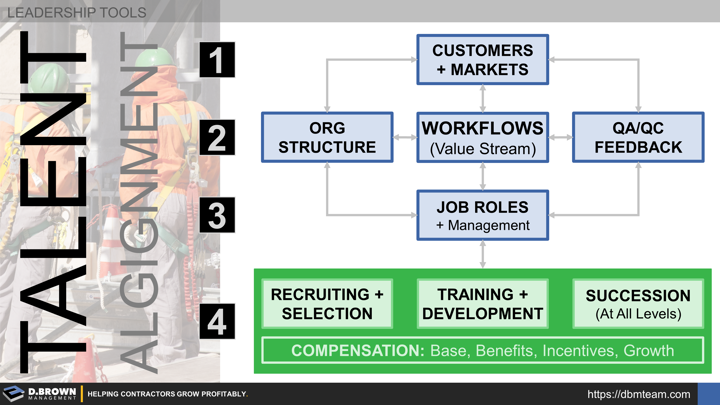The process is slow and iterative, however the tighter you align the elements in this model the better your organization will operate.
- EVERYTHING you do must align around your strategic market choices along with your strategic market experiments and the customers or potential customers within those markets.
- Your workflows (value stream, standards, systems, processes, tools, procedures) are what defines the optimum sequence of tasks, meetings, and decisions required. These workflows and associated performance standards are the details that make up your business model and must deliver value to your customers, employees, and owners.
- For critical parts of the workflow, there must be appropriate Quality Control (Right Outcomes) and Quality Assurance (Right Process) checks in place along with clear escalation paths if inputs or outcomes are not going as expected. This is the feedback loop and part of the continuous improvement process.
- These managerial checks are largely what helps define the organizational structure. Each management level of the organization has very different responsibilities. It is important to understand these, including how they evolve with headcount growth and expansion of geography or scopes of work. 8-minute video gives a quick explanation, and 2-hour video series gets into more detail.
- Job roles, including those for managers, are logical groupings of the tasks, meetings, and decisions required as part of the workflows. Higher level job roles would be focused on responsibilities for developing and implementing systems, integrating systems across multiple functional areas, and making major strategic decisions including major resource allocations. Get extreme clarity in your job role descriptions, including how they integrate with your workflows, how they are managed, and how they provide career progression over time. Remember that the job role description you use internally for training, management, and development looks very different than the recruitment marketing level job description that must answer five questions very clearly, while complying with state and federal laws.
- All aspects of your Talent Value Stream (TVS) must be integrated with the layers above including compensation. Compensation is the most tangible including base, benefits, incentives, and growth but it is not the driver. Remember that you need people with the right aptitudes and skills to fill the job roles. No amount of accountability or compensation will create competencies in a job role.
Compensation must be aligned with the market for a given set of capabilities, experiences, relationships, capacity, and aptitude that someone brings to the table. The talent market is extremely competitive for contractors and will continue to tighten through 2030.
There are four main levers a contractor can use to increase compensation. #1 is only viable in the short-term. #4 will fluctuate with market conditions. Make sure you know the difference between skill of making a strategic market choice and the luck of being in the right place at the right time.
- Lower to profitability of the company by paying it in compensation. If nothing else changes, this is the effect.
- Improve the workflows including tools for efficiency and reduction of rework through QA/QC processes. All other things being equal, more effective workflows will facilitate better cash flow and profitability that can be reinvested including through compensation.
- Narrow the scope of a job role to be more specialized so someone with less experience and a lower level of skill can be productive in it. This broadens the potential market for recruiting and lowers the cost of performing the task because the less experienced and lower skilled person will cost less. This requires clear workflows and management with the total cost having to be evaluated, not just the cost of the individual role. These efficiency gains are an advantage of growth and larger projects but bring their own challenges.
- Choosing market strategies where the project owners are paying at the top of the market. There can be two Project Managers with equal capabilities and therefore seemingly equal market value. That PM will be worth more to a project owner (paid through GC/CM and Subcontractors) on a project in a rapidly growing market sector like data centers as compared to a more stable or declining market sector.
The diagram and principles are simple. The execution is difficult and iterative. The important part is knowing where you are at and continuing to improve each day.

